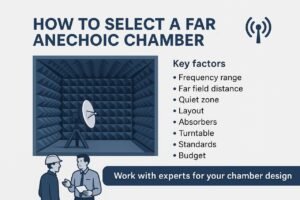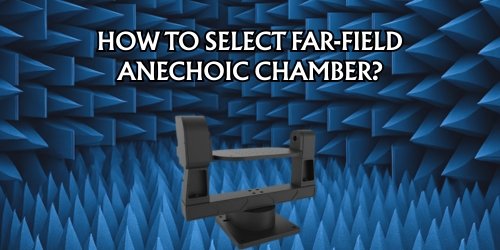How to Select the Right Far-Field Anechoic Chamber
Testing antennas, radars, and electronic devices requires a controlled environment free from reflections and external interference. Far-field anechoic chambers provide this environment, simulating free space conditions within an enclosed facility. Selecting the right far-field anechoic chamber is crucial for reliable, repeatable, and compliant measurements.
This guide explains key considerations when selecting a far-field anechoic chamber for your application.
What is a Far-Field Anechoic Chamber?
A far-field anechoic chamber is a shielded room lined with RF absorbers to prevent reflections and external noise, allowing accurate measurements of antenna radiation patterns, gain, and EMC performance. “Far-field” implies the distance between the antenna under test (AUT) and the measurement antenna satisfies the far-field condition, typically:
R=2D2λR = frac{2D^2}{lambda}R=λ2D2
where:
- RRR = far-field distance
- DDD = maximum dimension of the antenna
- λlambdaλ = wavelength
This ensures the radiated field behaves like a plane wave.
Key Factors in Selecting a Far-Field Anechoic Chamber
1. Frequency Range
Determine the frequency range of your testing requirements. Lower frequencies require larger chambers because the wavelength is longer, resulting in greater far-field distances.
For example:
- Below 1 GHz: Very large chambers needed due to long wavelengths.
- 1–6 GHz: Typical for wireless and radar testing; chamber sizes are manageable.
- Above 18 GHz: Requires shorter far-field distances, allowing compact chambers.
Ensure the chamber and absorber specification supports your frequency range without compromising performance.
2. Size of the Device Under Test (DUT)
Calculate the maximum dimension of your DUT. Larger antennas require:
- Longer far-field distances
- Wider quiet zones (test areas with minimal reflections)
Always consult chamber suppliers for recommended chamber length and width based on your DUT size and test standards.
3. Test Standards Compliance
Check if your tests require compliance with:
- IEEE 149 / ANSI C63.4: Antenna measurements
- CISPR 16-1-4 / ISO 11452-2: EMC measurements
Standards often dictate chamber characteristics, quiet zone size, and absorber performance.

anechoic chamber
4. Absorber Type and Performance
Far-field anechoic chambers use pyramidal absorbers to minimise reflections. Consider:
- Absorber height: Higher absorbers (e.g., 60 cm or 24”) provide better low-frequency performance.
- Power handling: For high-power testing, use absorbers with special coatings and cooling.
- Fire retardancy: Verify compliance with fire safety standards like UL-94.
For broadband tests, hybrid absorbers combining ferrite tiles (for low frequency) and pyramidal foam (for high frequency) are preferred.
5. Quiet Zone Requirements
The quiet zone is the usable test volume with minimal reflections. Its size depends on:
- DUT size
- Measurement accuracy needed
- Chamber design (absorber layout and source antenna positioning)
Discuss your required quiet zone dimensions with the chamber manufacturer to ensure sufficient measurement fidelity.
6. Chamber Type: Rectangular vs. Tapered
- Rectangular chambers: Economical, widely used for general antenna testing.
- Tapered chambers: Feature a tapered design towards the source antenna, improving performance by reducing reflections and standing waves, especially for radar cross-section (RCS) measurements.
Select based on your application and budget.
7. Budget and Installation Constraints
Far-field chambers are capital-intensive investments. Cost drivers include:
- Size (length and width)
- Absorber type and height
- Shielding effectiveness
- Structural construction (independent structure or integrated within existing building)
Additionally, consider:
- Floor loading capacity
- HVAC requirements for temperature control
- Electrical power for lighting and absorbers (if active absorbers are used)
8. Supplier Expertise and After-Sales Support
Choose suppliers with:
- Proven design expertise
- In-house absorber manufacturing
- Testing and calibration services
- Strong after-sales support for maintenance and requalification
Long-term support is critical to maintain chamber performance over decades of use.
Selecting the right far-field anechoic chamber involves careful evaluation of your test frequency range, DUT size, absorber performance, standards compliance, and budget. A well-designed chamber ensures:
- Reliable antenna radiation pattern measurements
- Accurate EMCtests without external interference
- Long-term investment returns through consistent results
Consult experienced chamber manufacturers, discuss your current and future testing needs, and plan for expansion possibilities. This ensures your far-field anechoic chamber becomes a strategic asset in your product testing and validation workflow.
Top 5 FAQs
What is a far-field anechoic chamber used for?
It is used for precise RF, antenna, and acoustic testing by eliminating external noise and reflections.
What size should the chamber be for accurate far-field measurements?
The chamber should be large enough to maintain the far-field condition (typically >2D²/λ, where D is antenna size).
What materials are used for electromagnetic absorption?
Ferrite tiles, pyramidal foam absorbers, and hybrid materials are common for different frequency ranges.
How important is the noise floor in an anechoic chamber?
Critical—lower noise floors ensure accurate measurements, especially for low-signal testing.
Which industry standards should the chamber comply with?
Look for compliance with IEEE, IEC, MIL-STD, or ANSI C63.4 for EMC/EMI testing.

